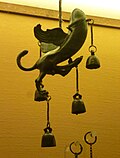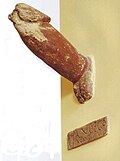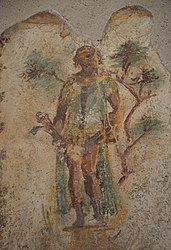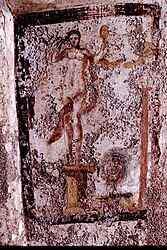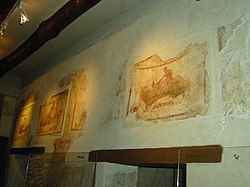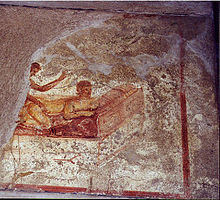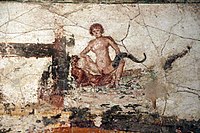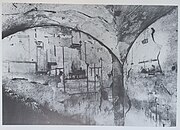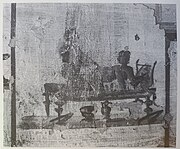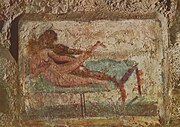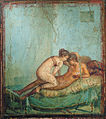Erotic art in Pompeii and Herculaneum has been both exhibited as art and censored as pornography. The Roman cities around the bay of Naples were destroyed by the eruption of Mount Vesuvius in 79 AD, thereby preserving their buildings and artefacts until extensive archaeological excavations began in the 18th century. These digs revealed the cities to be rich in erotic artefacts such as statues, frescoes, and household items decorated with sexual themes.

The ubiquity of such imagery and items indicates that the treatment of sexuality in ancient Rome was more relaxed than in current Western culture. The creation of erotic art in ancient Rome is thought to have occurred over seven centuries from the first century BCE to the fifth or sixth century CE.[1]
Much of what might strike modern viewers as erotic imagery, such as oversized phalluses, could arguably be fertility imagery. Depictions of the phallus, for example, could be used in gardens to encourage the production of fertile plants.
This clash of cultures led to many erotic artefacts from Pompeii being locked away from the public for nearly 200 years. In 1819, when King Francis I of Naples visited the Pompeii exhibition at the Naples National Archaeological Museum with his wife and daughter, he was embarrassed by the erotic artwork and ordered it to be locked away in a "secret cabinet", accessible only to "people of mature age and respected morals". Re-opened, closed, re-opened again and then closed again for nearly 100 years, the Secret Museum, Naples was briefly made accessible at the end of the 1960s (the time of the sexual revolution) and was finally re-opened for viewing in 2000. Minors are still only allowed entry to the once-secret cabinet in the presence of a guardian, or with written permission.
Phalluses
- Phallus relief from Pompeii, c. 1–50 AD
- Bronze tintinabulum; phallus in the form of a winged lion, with suspended chimes (1st C BC)
- A phallus from a public alleyway in Pompeii that was 2 meteres up the side of a wall. The inscription reads "I shat out this one phallus/prick".[2]Tufa. Painted.
- A phallus on the side of a building in Pompeii. Terracotta plaques with images of phalluses were set into the walls on streets in Pompeii.[2]
The phallus (the erect penis), whether on Pan, Priapus or a similar deity, or on its own, was a common image. It was not seen as threatening or even necessarily erotic, but as a ward against the evil eye.[3][4] The phallus was sculpted in bronze as tintinnabula (wind chimes). Phallus-animals were common household items.
Priapus
A wall fresco which depicted Priapus, the god of sex and fertility, with his oversized erection, was covered with plaster (and, as Karl Schefold explains, even the older reproduction below was locked away "out of prudishness" and only opened on request) and only rediscovered in 1998 due to rainfall.[5]The Romans believed that he was a talisman protecting the riches of the house.
The second image, from Schefold, Karl: Vergessenes Pompeji: Unveröffentlichte Bilder römischer Wanddekorationen in geschichtlicher Folge. München 1962., with its much more brilliant colors, has been used to retouch the younger, higher resolution image here.
A statuette of Priapus in the House of the Vettii in Pompeii is from a small cubicle leading off from the kitchen. It is thought the statue used to be placed in the garden and was used as a fountain. A hole runs through its phallus allowing it to spurt like a fountain. Also in this room where the statue was located were erotic paintings.
- A statuette of Priapus in the House of the Vettii. A hole runs through its phallus allowing it to spurt like a fountain.
- Wall Painting of Priapus, House of the Vettii
- A fresco of Venus and Priapus. Above them is a landscape. House at I. 62 - 79 CE
- A second image of the wall painting. House at I. 62 - 79 CE
Brothels

It is unclear whether the images on the walls were advertisements for the services offered or merely intended to heighten the pleasure of the visitors. As previously mentioned, some of the paintings and frescoes became immediately famous because they represented erotic, sometimes explicit, sexual scenes.
One of the most curious buildings recovered was in fact a Lupanar (brothel), which had many erotic paintings and graffiti inside. The erotic paintings seem to present an idealised vision of sex at odds with the reality of the function of the lupanar. The Lupanare had 10 rooms (cubicula, 5 per floor), a balcony, and a latrina. It was not the only brothel. The town seems to have been oriented to a warm consideration of sensual matters: on a wall of the Basilica (sort of a civil tribunal, thus frequented by many Roman tourists and travelers), an immortal inscription tells the foreigner: If anyone is looking for some tender love in this town, keep in mind that here all the girls are very friendly (loose translation). Other inscriptions reveal some pricing information for various services: Athenais 2 As, Sabina 2 As (CIL IV, 4150), The house slave Logas, 8 As (CIL IV, 5203) or Maritimus licks your vulva for 4 As. He is ready to serve virgins as well. (CIL IV, 8940). The amounts vary from one to two asses up to several sesterces. In the lower price range the service was not more expensive than a loaf of bread.
Prostitution was relatively inexpensive for the Roman male but it is important to note that even a low priced prostitute earned more than three times the wages of an unskilled urban labourer.[citation needed] However, it was unlikely a freed woman would enter the profession in hopes for wealth because most women declined in their economic status and standard of living due to demands on their appearance as well as their health.
Prostitution was overwhelmingly an urban creation. Within the brothel it is said prostitutes worked in a small room usually with an entrance marked by a patchwork curtain. Sometimes the woman's name and price would be placed above her door. Sex was generally the cheapest in Pompeii, compared to other parts of the Empire.[citation needed] All services were paid for with cash.
- Wall paintings from the Lupanar
- Erotic frescos on the walls of the Lupanar brothel
- Erotic Fresco from the Lupanar brothel. 72 - 79 CE[6]
- Fresco from the Lupanar brothel, the largest Pompeii brothel. 72 - 79 CE
- Erotic Fresco from the Lupanar, Pompeii. 72 - 79 CE
- Erotic Fresco from the Lupanar, Pompeii. 72 - 79 CE
- Erotic Fresco Lupanar, Pompeii. 72 - 79 CE
Suburban baths

A room that is thought to be a dressing room[7] in the suburban baths has on a wall inside it seven wall paintings of sexual scenes and one wall painting of a figure with an enlarged scrotum.[8]The Suburban Baths are located near the Marine Gate in Pompeii.[9][8]
These eight paintings are located above paintings of numbered boxes that are all sitting on a shelf.[8][1] These wall paintings were found in 1986[8][1] when the room was first excavated. The paintings are dated to 62 to 79 CE.[8][1] The building that the baths are in is two stories with the baths taking up the ground floor.[8]
The function of the wall paintings is not yet clear: some authors say that they indicate that the services of prostitutes were available on the upper floor of the bathhouse and could perhaps be a sort of advertising, while others prefer the hypothesis that their only purpose was to decorate the walls with joyful scenes, as these were in Roman culture.

Another idea that is speculated is that both the paintings of sexual scenes and the paintings of boxes with numerals on them were related to the use of spintria tokens that gave people access to a locker in the dressing room.[10][11]
Each wall painting of a sexual scene has a painting just below it of a box with a number on it.[8][12] It is thought that there were actual boxes that were placed under these paintings of boxes.[7]`[8] These boxes would have been placed on a wooden shelf.[7][8][12] This wooden shelf would have run along two walls of this dressing room just underneath where the paintings of numbered boxes are.[7]`[8] There are some holes in the rear and right wall where brackets that held the selves could have been.[7]`[8] It is thought that these boxes that were sitting on this wooden shelf under these paintings would have been where people attending the baths would have put their clothes after they had undressed in this room.[8] The only remains of the boxes themselves are metal straps.[12] In the wall paintings of the boxes you can see an "X" shape at the front of the boxes that indicates where the straps were.[1] The wall painting also shows the wooden shelf underneath the boxes.[8]
Spintria tokens have a numeral on one side and an image of a sexual scene on the other.[12] It is speculated that the sexual scenes and numerals on the tokens related[10] to the wall paintings of sexual scenes and numerals in the dressing room.[10] When the token was given to a person it then gave them access to a place to put their clothing.[10] Possibly they may have put their clothing inside the box that was sitting on the wooden shelf in the dressing room.[8]
It has been commented that "Graffiti from Pompeii, Herculaneum and 2nd century Ostia Antica, often refer to group sex, although none describe the pose of scene VI [from the suburban baths]."[13][14]
- Wall paintings from the dressing room in the suburban baths
- Fresco showing a cowgirl position. A ferret is on the knee of one of the figures. Suburban baths, Pompeii. 62 to 79 CE
- An erotic scene on a bed. Wall painting. Suburban baths, Pompeii. 62 to 79 CE
- Fellatio. Wall painting. Suburban baths, Pompeii. 62 to 79 CE
- Fresco depicting cunnilingus. Suburban baths, Pompeii. 62 to 79 CE
- Lesbian sex scene. The patches of dark green color are remains of the repainting of the wall. Suburban baths, Pompeii. 62 to 79 CE
- Sex between a female and two males. Wall painting. Suburban baths, Pompeii. 62 to 79 CE
- Cunnilingus, fellatio and anal sex between two females and two males. Wall painting, Suburban baths. Pompeii. 62 to 79 CE
- A nude male with an enlarged scrotum holding a scroll. Wall painting. Suburban baths, Pompeii. 62 to 79 CE
Venus

Venus was the divine protector of Pompeii, and featured in many frescoes around the city.[15] The goddess of love, sex, and fertility, Venus was closely associated with eroticism and prostitution in ancient Rome.[16] The mural of Venus from Pompeii was never seen by Botticelli, the painter of The Birth of Venus, but may have been a Roman copy of the then famous painting by Apelles which Lucian mentioned.
The fresco of Mars and Venus, located in the tablinum of the House of Mars and Venus, is believed to model the proper family roles of husband and wife for those entering the home. Mars and Venus, a popular couple from mythology, were represented in many houses' tablinum for this reason.[17] Venus has appeared in Pompeian artwork at least 197 times,[18] the majority of these depictions located in a home's reception area where a guest would not need an invitation to enter, although she also appears on tavern signs and political banners.[19] Previous scholarship assumed Venus would be more common in cubicula, small inclosed rooms that may function as a bedroom, due to her association with love and sex. Recent studies have shown this is not the case and that Venus is more commonly portrayed in large common rooms.[18] Approximately one third of artwork featuring Venus represents some sort of love scene.[20] There are two Venus types found almost exclusively in Pompeii, Venus Pompeiana ("Venus of Pompeii") and Venus Pescatrice ("Venus the Fisher-woman"). Venus Pompeiana is depicted standing rigidly, usually trapped with a mantle and holding her right arm across her chest.[20] She is most commonly depicted in places that would be seen by many people, possible to demonstrate a house's patron goddess or for protection as this form of Venus has special religious and ritual significance to Pompeii. Venus Pescatrice is typically shown sitting down, holding a fishing rod and is always semi-naked.[18] The depictions of Venus Pescatrice are all similar in strucuter, suggesting they derive from the same source, though this source has not been found.[18]
- Mural of Venus
Erotic art outside Pompeii and Herculaneum
In Ostia Antica in the House of the Painted Vaults there are two wall paintings of sexual scenes in one room.[21] It is speculated that in this room there was once six to eight paintings of sex between two people on beds.[21]
- The same room in a different image. The west wall painting was removed for conservation. Fresco. House of the Painted Vaults mid-3rd century CE.[1]
- West wall painting. Excavation photo. Fressco. House of the Painted Vaults. mid-3rd century CE.[1]
- South wall painting. Excavation photo. Fresco. House of the Painted Vaults. mid-3rd century CE.[1]
- South wall painting. Fresco. House of the Painted Vaults. mid-3rd century CE.[1]
- Above the two figures on a bed is an image inside a shutter. This picture shows a sexual scene between two people. Bronze mirror cover. 70 - 90 CE
Gallery
- Mythology
- A statuette of Aphrodite with eros. Some of the body decoration is gilt. From Pompeii. National Archaeological Museum, Naples.
- Polyphemus and Galatea kissing. Fresco from a Pompeii sleeping room. Naples National Archaeological Museum. around 50 CE – 79 CE
- Fresco showing Leda and the swan, from Pompeii, National Archaeological Museum, Naples 50–79 CE
- Fresco showing Leda and the swan. From Pompeii.
- Venus and Eros. Wall painting from Pompeii.
- Nymph, Maenad and Satyr
- Tile mosaic, Nymph and a Satyr, House of the Faun.
- A Nymph or Maenad sleeping in a landscape with a Satyr approaching. From Pompeii. Around 50–79 CE.
- Maenad and a Satyr, from Pompeii
- Erotic scenes
- Marble bas-relief from Pompeii. National Archaeological Museum, Naples.
- A sexual scene on a bronze vessel handle. From Pompeii. 1st century CE
- Erotic scene on the Nile. Roman fresco on summer triclinium of the House of the Ephebus. Pompeii.
- Erotic fresco. Pompeii.
- Erotic wall painting from Pompeii. Around 50 to 79 CE.
- Wall painting from Pompeii
- Sex between a female and a male.The figure on the left is wearing a strophium which is a kind of bra or bikini top.[22] From the House of the Centenary, Pompeii. Around 70CE
- Erotic wall painting, Pompeii, 1st century
- An erotic wall painting on the west wall of a small room at the side of the kitchen from The House of the Vettii, Pompeii. [23]
- Erotic wall painting East wall. House of the Vetti, from Pompeii
- Erotic wall painting. North Wall, House of the Vetti. from Pompeii
- Erotic wall painting. South wall. Casa del Ristorante. Pompeii
- Erotic wall painting. West wall. Casa del Ristorante. Pompeii
- Erotic wall painting. North wall Casa del Ristorante. Pompeii
- Erotic wall painting. North wall. Casa del Ristorante. Pompeii
- Erotic wall painting, House of the King of Prussia, Pompeii
- Erotic wall painting, from Pompeii, National Archaeological Museum, Naples.
- Sex between a female and a male.The figure on the left has a garland of rose petals around their head. The figure to the right is wearing a strophium which is a kind of bra or bikini top.[22] Pompeii. Around 70CE
- Erotic wall painting, from Pompeii. National Archaeological Museum, Naples.
- Erotic wall painting, from Pompeii. National Archaeological Museum, Naples. 62 - 79 CE
- Erotic wall painting, from Pompeii. National Archaeological Museum, Naples.
- Sexual scene - House at I. 13, 16 - Pompeii
See also

References
Bibliography
- Clarke, John (2003). Roman Sex: 100 B.C. to A.D. 250. New York: Harry N. Abrams. ISBN 978-1626548800.
- Grant, Michael; Mulas, Antonia (1997). Eros in Pompeii: The Erotic Art Collection of the Museum of Naples. New York: Stewart, Tabori and Chang. ISBN 978-1556706202.
- McGinn, Thomas A.J. (2004). The Economy of Prostitution in the Roman World. Ann Arbor: The University of Michigan Press. ISBN 978-0472113620.
- Varone, Antonio (2001). Eroticism in Pompeii. J. Paul Getty Museum. ISBN 978-0892366286.
{{cite book}}:|work=ignored (help)

